Authenticity
Chapter 3 - Justification for Inscription
- Criteria under which inscription is proposed
- Proposed statement of outstanding universal value
- Comparative analysis
- Authenticity
D. Authenticity
In addition to its historical and technological significance, the nominated property fulfils the conditions of authenticity set out in Section II E of the Operational Guidelines. The authenticity of the nominated site can be attributed, in large measure, to the high degree of engineering skill and workmanship in the construction of the original engineering works, fortifications and buildings. In addition, ownership of the nominated site by the Government of Canada since the later decades of the 19th century has been a major factor in the survival of original structures and ensembles of structures, and their high state of conservation. Aspects of the Rideau Canal as they relate to the conditions of authenticity set out in the guidelines are described below.
1. Authenticity in form and design
The Slackwater System
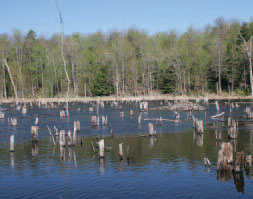 Large areas were flooded during the construction of the canal. Dead tree stumps are still visible in many locations. © Parks Canada |
The Rideau Canal, as a slackwater canal system, has a high degree of authenticity, since the original plan and layout of the route, as well as the depth and width of channels, have remained completely intact. During construction, watercourses and adjacent lands along the route were significantly modified by the construction of dams and locks. Rapids, rocky shallows and swamps were flooded to create navigable channels, lakes and rivers. These features all remain in evidence today.
Engineering Works
Locks
The original forty-seven lock structures of the Rideau Canal have retained their locations and dimensions as built. In the 1880s, two locks were built at Beveridges Lockstation as part of the Tay Canal. They also have retained their locations and dimensions as built. To facilitate the road crossing of the canal at Smiths Falls Combined Lockstation, a single-chamber concrete lock was built in the 1970s in proximity to the original three locks in flight, which have been preserved in their original form and location.
Including the two locks at Beveridges and the single-chamber lock at Smiths Falls, there are now fifty lock chambers on the canal. Forty-one of them are classified as Level 1 cultural resources, and two are Level 2 cultural resources, according to the Parks Canada Agency’s Cultural Resource Management Policy . These numbers are indicative of the high level of authenticity of the Rideau Canal’s locks. (CRM levels are explained in chapter 2, section A).
Lock Gates
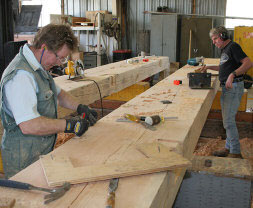 Gates have a life span of up to twenty-five years. New gates are made by Parks Canada Agency staff, following the design of the originals. © Parks Canada |
Due to deterioration of the wood from harsh winters and regular use, the timber-frame gates on the Rideau Canal have a life span of approximately twenty to twenty-five years. This frequency of replacement is similar to the replacement schedule during the canal’s historic period. Replacement gates are manufactured by skilled Parks Canada Agency craftsmen, who pattern the new gates after the original design.
Dams
With very few exceptions, the canal’s dams, consisting of earthen embankments, stone masonry dams, spillways and weirs, exist today in their original locations and still play their original roles in creating the slackwater system. In response to water management and public safety requirements, some dams have undergone varying degrees of replacement.
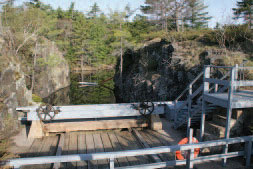 The Jones Falls weir is part of the complex system of dams at this lockstation. © Parks Canada |
There are seventy-four dams along the Rideau Canal, of which twenty-three have received a CRM Level 1 rating, indicating their authenticity with respect to form and design. Fourteen dams have received a CRM Level 2 rating. The most significant dam engineering achievement on the canal was the seven stone arch dams built as part of the original plan. All of these survive in their original form and design.
Bridges
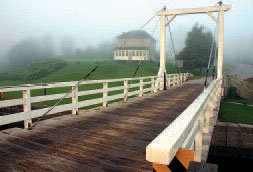 Authentic designs were used to construct the king post swing bridges found today at some lockstations. © Parks Canada |
When the Rideau Canal was built in the wilderness of eastern Ontario, there was virtually no need to include bridges in the design of engineering works for the lockstations. As the population of the area increased and the road system developed, swing bridges were built at a number of lockstations to cross the canal. Twelve such bridges are included in the nominated property and together demonstrate the evolution of bridge form and design. Three of the twelve are original steel swing bridges. They are located at Burritts Rapids Lockstation (1897), The Narrows Lockstation (1898) and Long Island Lockstation (1903) and classified as CRM Level 2 resources. Four of the original timber bridges were replaced using authentic designs. The remaining five bridges are steel replacements that were installed to meet vehicle traffic needs or because of the physical condition of the originals.
Lock Operating Mechanisms
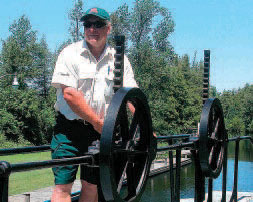 Lock gates and sluice valves are still operated using hand-powered winches. © Parks Canada |
When the canal opened in 1832, three different operating mechanisms were used, all operated by hand-powered winches. In addition, hand-powered winches were used to operate the sluice valves for the locks. These operating systems are still in use today at most locks on the canal. Only three of the canal’s fifty locks now have hydraulic/electric operating systems for gates and sluices. These are Black Rapids, Smiths Falls Combined, and Newboro.
Canal Buildings and Fortifications
Twenty-three buildings associated with the nominated property date from the construction period and demonstrate the strategic military purpose of the canal. They have been assessed under the CRM Policy as Level 1 resources. In addition, there are buildings from the postconstruction period included in the nominated property. Their form and design reflect the evolution of the property, the different periods of their construction and the specific functions that they were intended to serve. Sixteen of these buildings are CRM Level 2 resources.
The CRM Level 1 buildings include the fortifications at Kingston and the canal’s blockhouses and defensible lockmaster’s houses. In form and design, Fort Henry and the four Martello towers are as built in the 19th century, except that the main floor of both Shoal Tower and Cathcart Tower is now missing and partition walls of the storage level have collapsed. Of the six blockhouses built to defend the Rideau Canal, four survive (Merrickville, The Narrows, Newboro and Kingston Mills). Although they were adapted for other uses when no longer needed for defensive purposes, all have now been restored to their original appearance.
The defensible lockmaster’s houses were small, square, one-storey stone buildings, with small window openings and incorporating loopholes for rifle fire. When it became clear that they were no longer needed for defensive purposes, they were altered to make them more habitable. Many were enlarged through the addition of a second storey. A large number of these houses survive with their original form and design retained as part of the adapted structure.
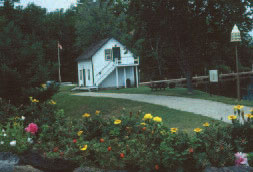 Later in the 19th century, stone gave way to wood for the construction of lockstation buildings. © Parks Canada |
The CRM Level 2 buildings associated with the nominated property date from later in the 19th century to the 1930s. Following the military era, additional houses were built for lockmasters, and several lockmaster’s houses were built in the first decades of the 20th century. They are all similar in design: plain, rectangular, two-storey frame structures. Also in the early 20th century, a few houses were built for the accommodation of canalmen. They resembled the lockmaster’s houses of that period, but were smaller in size.
In the early days of the canal and for many years thereafter, lockmaster’s houses were the lockstation offices as well. In the late 19th century, buildings intended to serve as separate lockstation offices were introduced. The lockstation office at Davis was built in 1875 and, in design, was similar to a domestic building. In contrast, the lockstation office built at Ottawa Locks in 1884 is, despite its small size, an impressive stone-built structure. Purpose-built lockstation offices continued to be constructed up to the 1970s, although a number of lockstation offices in use today were adapted from existing lockmaster’s houses.
2. Authenticity in materials and substance
Locks
Nearly all of the Rideau Canal’s locks are in their original state of construction with a high percentage of original stone. At the time of their construction, locks had either stone-masonry or timber floors. While it has been possible to retain the stone masonry, the timber floors were replaced with concrete at an earlier time. These evolved lock structures are now conserved in their current state as part of the life-cycle maintenance program.
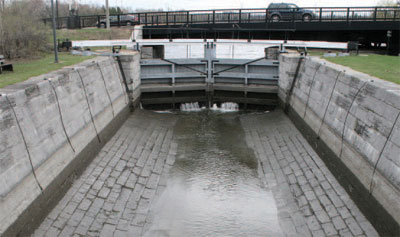 Original masonry floors survive at many locks. The timber floors used at some locks have been replaced by concrete. © Parks Canada |
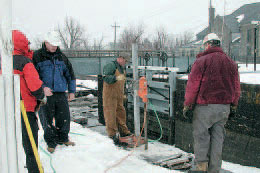 New techniques are now used for grouting, causing less damage to original fabric. © Parks Canada |
In the past, the periodic stabilization of lock walls was undertaken by dismantling the walls and reconstructing them. The Parks Canada Agency has since adopted new maintenance techniques that conserve original stone-masonry lock walls. The current technology uses core drilling and pressure grouting techniques so the wall can be stabilized in place. As a result, there is less damage to original stone blocks and greater protection of original fabric. When, however, it is necessary to replace stone blocks, it is normal practice throughout the canal to use new stone similar in composition to the original.
Only one original lock (Black Rapids) has been entirely rebuilt with the use of concrete, and five locks (Ottawa Locks 1–5) have been rebuilt with stone matching the original.
Gates
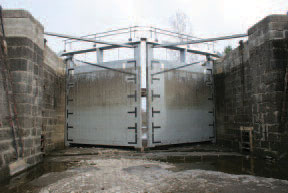 Originally made of oak, lock gates are now made of Douglas Fir due to the lack of oak of sufficient size. © Parks Canada |
The wood originally used for building lock gates was native oak, but now, when gates are replaced on a twenty to twenty-five year cycle, British Columbia Douglas Fir is used, due to the scarcity of oak large enough to fashion the timbers. Iron and steel fittings are conserved from one set of gates to the next to the greatest degree possible. When replacement pieces are required, the original material and form are duplicated.
Dams
Twenty-three of the seventy-four dams of the Rideau Canal, including the seven stone arch dams, retain their original materials. Because of the importance of the dams as water control structures and in order to meet evolving safety standards for such structures, some of the original stone- masonry dams have been replaced over time using concrete. Fourteen of these early concrete dams represent the evolution of canal engineering and have been classified as CRM Level 2. The canal’s earth embankment dams retain their original materials, including their clay puddle cores, but have, in some instances, been reinforced with additional earth or stone.
Bridges
The oldest surviving bridges on the canal date from the 19th and the early 20th centuries and were made of steel. When repairs are necessary, steel is used. The timber bridges now found on the canal are, in design, authentic replacements of the originals and use authentic materials to the greatest degree possible.
Lock Operating Mechanisms
As components of lock operating mechanisms age and wear, they are repaired to conserve original material such as timber, cast iron, wrought iron and steel. When necessary, they are replaced using authentic materials.
Canal Buildings and Fortifications
Most buildings dating from the construction period of the canal are made of stone, although the four surviving blockhouses were stone on the first level, with a frame second level. The fortifications at Kingston are stone, although the four Martello towers have wooden roofs. Of the two lockstation offices dating from the 19th century, one is stone, the other, frame. For the most part, the 19th century alterations made to canal houses consisted of adding to them a frame second storey. Houses built in the early 20th century are frame.
Repairs made to these buildings aim to conserve the original material as much as possible; if replacement of fabric is necessary, the original materials are duplicated.
3. Authenticity in use and function
In 2007, the Rideau Canal will celebrate its 175 th year of continuous operation. Over its entire history, the transportation function of the canal has been maintained. While military and commercial uses have given way to recreational boating, the experience of using the canal, travel distances, and travel time have remained the same. Today’s pleasure boater experience the process of ‘locking through’ the canal in much the same way that the earliest travellers did.
By the 1860s, Fort Henry and the four Martello towers, and the blockhouses and defensible lockmaster’s houses along the canal were outmoded for defensive purposes although some buildings continued to be used by the military, in Fort Henry’s case until after the First World War. Today, several of these fortifications are used for the interpretation of their original military function. Fort Henry is used to convey the life of the garrison stationed there in 1867. Fort Frederick and Murney Tower are museums and part of their programming is devoted to the history and significance of the fortifications at Kingston. Kingston Mills Blockhouse, the defensible lockmaster’s houses at Jones Falls and Chaffeys, and the Merrickville blockhouse present the military function of these small-scale fortifications.
4. Authenticity in traditions, techniques and management systems
Built by the British government, the Rideau Canal was transferred to the Province of Canada, and then to the Dominion of Canada in 1867. The British government retained possession of Fort Henry and the Martello towers until 1870, at which time they, too, were transferred to the Canadian government. Both the canal and the fortifications are still the responsibility of the federal government, and this continuity of government ownership has been a major factor in the survival of original structures and ensembles of structures, and their high state of conservation.
For nearly 175 years, without interruption, the Rideau Canal has been an operating waterway, fulfilling its original function as a transportation route between Ottawa and Kingston. While management methods have evolved over time, there has been considerable continuity in the operation of the canal. For example, the job of the lockmaster has existed since 1832, and lockmasters of the Rideau continue to exercise their responsibilities in a manner that is continuous with their line of predecessors, and a part of a long tradition of service to the public. Moreover, most locks are still operated in the traditional way with hand-powered winches used to open gates and sluice valves.
The property is managed in accordance with conservation principles, which means that, to the greatest degree possible, techniques used in the maintenance and conservation of the cultural resources of the property respect the integrity of the original workmanship. Cultural resources that demonstrate the authentic techniques of construction are conserved. While lock gates and other wooden structures must be re-structured or replaced from time to time, the designs used are authentic. Modern tools are often used for efficiency, but the methods of layout and fabrication follow the original construction techniques.
5. Authenticity in location and setting
The course followed by the Rideau Canal along its 202-km route from Ottawa to Kingston is unchanged, but the setting through which it passes has, in some areas, evolved considerably since the canal was completed. The Rideau now passes through cities and towns that were small communities in 1832: Ottawa, Merrickville, Smiths Falls and Kingston. Extensive farms are found along the route, particularly in the region between Ottawa and Smiths Falls. Cottage and resort development has taken place, notably in the area of the Rideau lakes. Nevertheless, almost half of the canal’s shorelands exists today in a natural state.
The location of the canal’s twenty-four lockstations is also unchanged as is the location of the various Level 1 and Level 2 buildings and dams dating to the 19th and the early 20th century. In the case of the fortified lockmaster’s houses and the blockhouses, this means that their defensive function is still clearly evident. The grounds around the locks are better maintained than in the 19th century and, in contrast to their treeless state in the construction period, lockstations now are well-treed, especially those outside of urban settings.
Except for Cathcart Tower, located on an uninhabited island off the shore from Point Henry, the setting within which the Kingston fortifications are found has changed considerably as the city has grown around them. Property to the north of Fort Henry has been developed. Shoal Tower, set in the midst of Kingston Harbour, is bordered by a public marina. Fort Frederick is just south of the extensive campus of the Royal Military College of Canada and the Queen’s University campus is to the north of Murney Tower. Because of their locations on the water, the fortifications are, however, still understandable in terms of their original function. They exist today with their geographic distribution, tactical logic and fields of artillery fire immediately observable.
- Date modified :